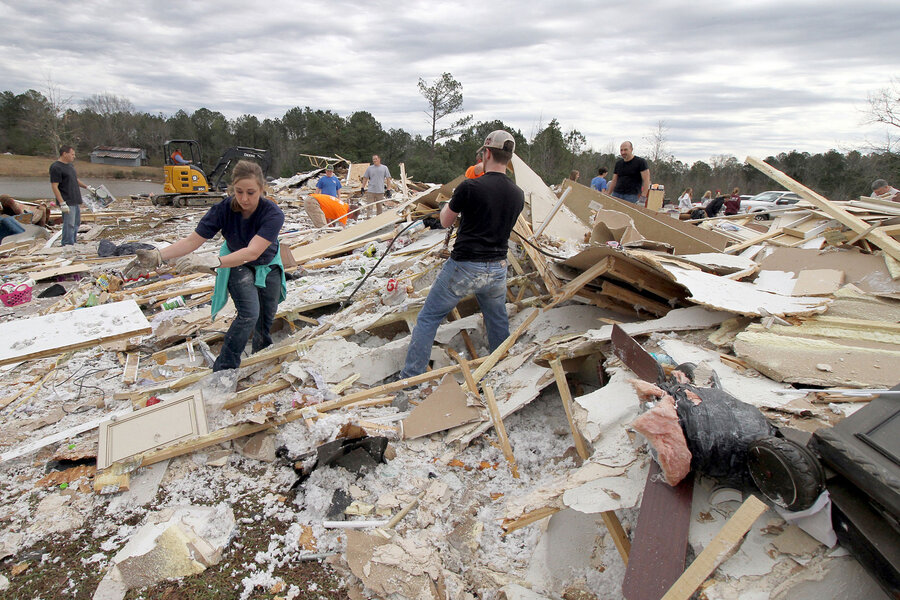Are improved tornado warning systems making a difference?
Loading...
The Wilkins family of Aliceville, Ala., saw storm warnings on the news, but they were still not expecting their home to receive a direct hit from one of a string of tornadoes across the South on Tuesday and Wednesday. The Wilkins home, like dozens of others in the area, is mostly destroyed, but they are grateful the family is safe, Adam Ganucheau reported for AL.com.
"Looking at the house yesterday and looking at it today, it's hard to come up with the words to describe how it feels," Bobby Wilkins told Mr. Ganucheau. "All I can do is thank God we're alive."
At least 10 tornadoes left parts of Georgia, South Carolina, Alabama, Mississippi, and Tennessee with significant structural damages, but local agencies were prepared by weather alert systems.
While the unusual storm system caused extensive property damages, only minor injuries have been reported so far, according to Sean Breslin for the Weather Channel.
National agencies, including the National Oceanic and Atmospheric Administration (NOAA) and National Weather Service (NWS), have made a concerted effort to improve disaster warnings ever since hurricane Katrina killed more than 1,000 people in 2005, Patrik Jonsson wrote for The Christian Science Monitor:
In the past decade, the US has dramatically improved disaster detection and warning efficacy, with lead times for tornado warnings growing from four to 13 minutes, a fact that likely saved lives in the 2013 Moore, Okla., tornado. Much of the progress has come from the increased processing capacity of computers and the ability to integrate very granular radar data with on-the-ground observations.
The next step, though, is communicating this information to residents on the ground. Officials are experimenting with the balance between a measured call for caution and panic-inducing language, as Pete Spotts wrote for The Christian Science Monitor.
The Storm Prediction Center issued an Enhanced risk outlook and as much as 15 minutes warning for the tornadoes in many areas, according to a blog by Dan Satterfield, an on-air meteorologist in the South.
State and local agencies also prepared with on-the-ground relief by Wednesday. Alabama emergency management officials were still in active disaster mode by Thursday morning.
In Georgia, where, ironically enough, February 1st through 5th is "Severe Weather Preparedness Week," Wednesday's state-wide tornado drill was cancelled as the officials turned their attention to issuing actual tornado warnings using all available media.
"We're very fortunate to be talking about loss of property instead of loss of life today," said Art Faulkner, the director of the Alabama Emergency Management Agency, AL.com reported. "Local and state officials were clearly prepared for this storm, and their preparedness undoubtedly saved lives."
This is particularly remarkable because February tornadoes are often more dangerous, if less common, than summer tornadoes, The Christian Science Monitor's Bamzi Banchiri reported. They are more likely to touch down after dark because the days are shorter, which makes them harder to spot and means more people are asleep or otherwise unprepared.
This was the case for Anthony Walker, who lives in one of the hardest-hit areas in Alabama and was awakened by the storm.
"It's the first time in about 25 years a tornado hit here," Mr. Walker told AL.com. "Everybody all the way back down there has damage for about a mile or two."
He and his neighbors worked through the night to salvage what they could from wrecked homes.
"We made it around to all the houses and I'm glad everybody got out," Devodrick Jackson told AL.com. "I don't really care about the materialistic stuff, I'm just glad no one got badly injured or killed."






